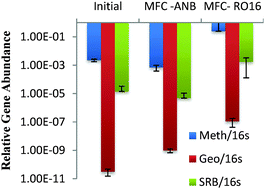Studies on the biodegradation of two different azo dyes in bioelectrochemical systems
Abstract
A comparative study on the degradation of acid navy blue R (ANB) and reactive orange 16 (RO 16) was performed in two identical microbial fuel cells (MFCs) under similar conditions and the microbial communities were quantified using a quantitative real time polymerase chain reaction (qPCR). Electricity and methane gas were produced as the end products along with the significant removal of chemical oxygen demand (COD) during the study. The overall performance in terms of degradation rate, COD removal efficiency and biogas production rates were slightly better in the case of the reactor using RO 16 as the carbon source, while electricity production was slightly greater in the reactor treating ANB. A negative standard reduction potential of the reaction mixture indicates the presence of oxidized species in the reactor. Scanning electron microscopy images show the presence of diatoms and rod shaped bacteria in the mixed microbial culture and also confirmed the formation of a biofilm on the anode surface. The qPCR technique was used as a quantitative tool to estimate the abundance of methanogens, sulphate reducing bacteria (SRBs) and electrochemically active Geobacter species. The relative abundance of methanogens was comparatively higher and Geobacter was lower in the case of the reactor treating RO 16. Although the output power was low, this technique can be used for the effective degradation of complex and toxic compounds.


 Please wait while we load your content...
Please wait while we load your content...